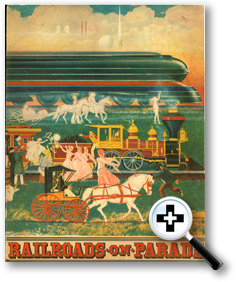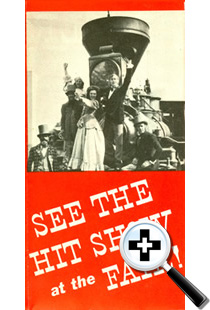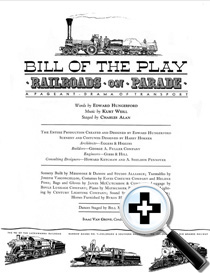In a 3,000-seat theater, with a cast of 250 members, Railroads on Parade reenacted the progress of rail transportation from the 1820s through 1939.
The goal of Edward Hungerford was to briefly tell the story of the railroad through a series of stage presentations, with narration and incidental music.
The following is a quote from the opening paragraph in the Railroads on Parade program guide. "into every corner of our social and economic existence, the railroad is tightly interwoven. It is the backbone of he country, no, even more, it is its veritable lifeblood. In its 250,000 miles of steel veins, it flows to every far corner of a far-flung land, it binds in its living, throbbing embrace city and town and village, the open country, the forest, the mine, the forge, the factory, and the sea. It is indeed the nation's lifeblood, the great arm not only of its industry, but of its military defense. If it were to die, then the nation would die."

- Edward Hungerford created the pageant. Rather than a series storyline with heroes and villains, Hungerford pieced together a series of tableaus representing the development of transportation in the United States, highlighting the important moments of railroad history. The pageant employed 250 actors and support staff and twenty-five animals. The twenty-five historic engines used in the production were kept perpetually under a full head of steam as they moved through the stage set or backstage area.
- While the audience followed the show through the aegis of a narrator, occasionally the on-stage players provided dialogue or sang an appropriate piece of music. However, intrepid columnist Meyer Berger discovered that in a sub-meadow control room, four men and a woman provided the actual dialogue and a chorus of eighteen men and women sang the songs. All the while, the onstage actors merely lip-synched.
- Henry Beckett informed readers of his syndicated column: "If I could attend the fair only once and my resources were limited to the price of admission and twenty-five cents, I would carry my lunch and blow that quarter on 'Railroads on Parade.'''
- Isaac Van Grove, the conductor for the pageant's orchestra noticed a strange musician in his ensemble. The young man confessed he was earning $8.00 that day so the actual performer could watch the show from the audience.
- The stagecoach used in one scene belong to the exclusive Sugar Hill resort in the White Mountains of New Hampshire. Chief Justice Charles Evans Hughes and John D. Rockefeller had ridden in the Abbott Downing Co. ("the General Motors of its day) product.
- Henry Ford loaned the DeWitt Clinton engine from his private collection but insisted a yellow tarpaulin be placed on it overnight and watched over by two security guards.
- The costumes were designed for comfort during the summer months. However, May proved to be exceptionally unseasonal and twelve of the cast members promptly caught colds and required understudies.
- The Fair's underachieving attendance put a strain on "Railroads on Parade." By late August, the Eastern Railroads Presidents Conference withdrew is financial support. The Pennsylvania Railroad took over as soul sponsor.


Courtesy of Bob Catania

Play for Railroads on Parade
- Return to:
- Railroads
- Transportation
